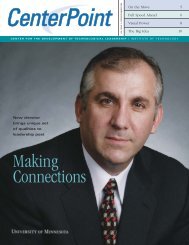Critical - Technological Leadership Institute - University of Minnesota
Critical - Technological Leadership Institute - University of Minnesota
Critical - Technological Leadership Institute - University of Minnesota
You also want an ePaper? Increase the reach of your titles
YUMPU automatically turns print PDFs into web optimized ePapers that Google loves.
Applying knowledge to the benefit<br />
<strong>of</strong> the infrastructure<br />
When Terry<br />
Ward entered<br />
the Master <strong>of</strong><br />
Science in Infrastructure<br />
Systems<br />
Engineering (ISE)<br />
program at the<br />
Center for the<br />
Terry Ward<br />
Development <strong>of</strong><br />
<strong>Technological</strong> <strong>Leadership</strong>,<br />
he was looking for a challenge.<br />
“I was at a point in my career where my<br />
day-to-day work activities were becoming<br />
routine,” says Ward, who works for the<br />
<strong>Minnesota</strong> Department <strong>of</strong> Transportation<br />
(Mn/DOT). His wife recommended that<br />
he pursue the ISE program, and he also<br />
wanted to set an example for his sons<br />
about the importance <strong>of</strong> education.<br />
His ISE experience also helped prepare<br />
him for his current challenge. Mn/DOT<br />
recently selected Ward to serve as a<br />
member <strong>of</strong> the project management team<br />
for the St. Anthony Falls (35W) Bridge<br />
design-build project.<br />
“I feel my selection was based on my<br />
ability to view things from a broad-based<br />
perspective, my abilities to be a strong<br />
team player, and my abilities to deliver<br />
high-quality products and services with<br />
limited resources and information,”<br />
says Ward, who serves as deputy project<br />
manager for construction on the team.<br />
“These were all skills that I strengthened<br />
through the ISE program.”<br />
While in the program, Ward led the<br />
ROC 52 design-build project in Rochester,<br />
Minn., as its project manager. “This was<br />
a major urban reconstruction project that<br />
represented some historic milestones for<br />
Mn/DOT,” he says. The ROC 52 project<br />
was the first Mn/DOT project to use<br />
design-build, where both the design<br />
and construction are completed by a<br />
contractor, and at the time, the largest<br />
project in the department’s history.<br />
Although challenging, attending school<br />
while working brought rewards.<br />
“The ISE program is very practical and<br />
directly related to my role as project<br />
manager,” he says. “I was able to<br />
complete many <strong>of</strong> the class assignments<br />
by solving problems that I was currently<br />
facing at work. I was also able to apply<br />
what I learned directly in my daily work<br />
on a regular basis.”<br />
The ISE program also <strong>of</strong>fered Ward a<br />
deeper understanding <strong>of</strong> infrastructure<br />
as a whole and <strong>of</strong> the ways that his job<br />
fit into the bigger picture.<br />
“The ISE program really helped me take<br />
a much broader perspective on the day-today<br />
issues and problems,” he says. “I have<br />
a much stronger skill set and am able to<br />
perform at a much higher level. I gained<br />
much more confidence in my problemsolving<br />
and teamwork abilities and am<br />
much better equipped to address the<br />
challenges that I face on a daily basis.”<br />
bottom-up paradigm for modeling, simulation,<br />
control, optimization, and protection <strong>of</strong><br />
operations—both financial and physical—in<br />
complex networks,” says Amin. “We showed<br />
that practical methods, tools, and technologies<br />
based on advances in these fields are allowing<br />
power grids and other interdependent infrastructures<br />
to self regulate, including automatic<br />
reconfiguration in the event <strong>of</strong> failures, threats,<br />
or disturbances.”<br />
Additional applications included development,<br />
application and use <strong>of</strong> distributed intelligent<br />
sensor technologies and control methodologies<br />
in the monitoring, management, and maintenance<br />
<strong>of</strong> critical infrastructure.<br />
The results were incorporated into other<br />
programs, such as the Consortium for Electric<br />
Infrastructure to Support a Digital Society, the<br />
Electricity Infrastructure Security Initiative, and<br />
in five resultant energy and defense programs.<br />
Another area that holds promise in addressing<br />
the design, control, and protection <strong>of</strong> complex<br />
infrastructure systems is complex adaptive<br />
systems (CAS), says Amin.<br />
“The overall behavior <strong>of</strong> CAS, such as interlinked<br />
national infrastructures, emerges through the<br />
independent behavior <strong>of</strong> simple, but adaptive and<br />
interacting components—a phenomenon known<br />
as self-organized complexity,” he says. “The global<br />
behavior <strong>of</strong> a CAS can be influenced by the actions<br />
or experiences <strong>of</strong> individual components.”<br />
The whole combined infrastructure is a CAS<br />
that consists <strong>of</strong> many individuals and frequently<br />
autonomous components, says Amin. CAS models<br />
are attractive because they can produce complex<br />
emergent phenomenon from a small set <strong>of</strong> relatively<br />
simple rules, constraints, and relationships. Two<br />
CDTL faculty members are exploring CAS as part<br />
<strong>of</strong> their work and in the classroom (see story on<br />
page 9).<br />
Spotlight for the Future<br />
CDTL has proposed an all-<strong>University</strong> interdisciplinary<br />
symposia series on security science and<br />
Vaughan Voller<br />
Fall 2007








